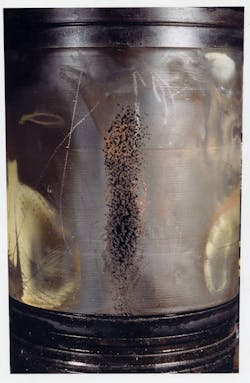Cavitation Causes and Cures
Pitting of wet cylinder liners is a continual threat in many diesel engines. The process by which liners can be pitted (and eventually perforated) is often called “cavitation,” but the process is better described, says Shell’s Stede Granger, as “cavitation/erosion/corrosion.”
As a diesel operates, says John Deere’s Mark Peckenschneider, it can set up harmonic vibration in the liners, which can be amplified by loose-fitting liners. During vibration, the liner pulls away from the adjacent coolant, subjecting coolant to a lower pressure, says Granger, thus lowering its boiling point and causing the liquid to suddenly vaporize. As liquid vaporizes (forming tiny bubbles), it absorbs energy and goes to a higher energy state—this is the latent heat of vaporization, says Granger.
When the liner springs back, says Granger, pressure increases, the boiling point increases, and the vapor bubbles implode and return to a liquid, releasing the latent heat of vaporization and resulting in a sudden micro-jet of liquid, which impinges on the liner wall. Think of it as a pressure-washer jet, says Granger.
“What the burst does is completely clean, or erode, the liner of any protection,” he says, “subjecting that area to corrosion if it’s not quickly protected by additives in the coolant. Shell is of the opinion that damage to the liner is actually corrosion of the unprotected surface. Any time there’s a corrosion site, an electrical imbalance is created, and if the coolant is an OAT type, additives are attracted to the site electrochemically and stop corrosion from taking place. When the electrochemical imbalance goes away, the OAT molecule is released to fight corrosion another day.”
And if the coolant’s OAT chemistry is supplemented with nitrite?
“Then both offer protection by different mechanisms,” says Valvoline’s Dr. David Turcotte. “The implosion of bubbles from cavitation, boiling, causes damage quickly, removing the protective oxide layer from the metal; this causes pitting, with repetitive damage removing metal. Nitrite works quickly to reform the metal-oxide protective layer, preventing further damage. The organic additives form protective barriers that maintain and add to the oxide layers. These layers offer cushioning or additional protection from cavitation and corrosion, but when removed, are slower to reform.”
